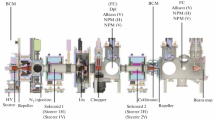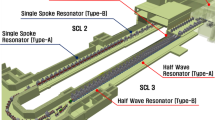Abstract.
The ISAC facility at TRIUMF utilizes up to 100 μA from the 500 MeV H- cyclotron to produce the RIB using the Isotopic Separation On Line (ISOL) method. The ISAC-I facility comprised the RNB production target stations, the mass separator and the beam delivery to low energy area and to a room temperature linear accelerator composed of a 4-rod RFQ and an inter-digital H type structure Drift Tube LINAC. ISAC-I linear accelerator can provide beam from A = 3 to 30 amu with an energy range from 0.15 to 1.5 A MeV. Since the beginning of operations target development program has been to increase proton beam currents on targets. Now we routinely operate our target at 50 to 85 μA and recently we have operated our target at 100 μA. Other developments are in place to add other ion sources, laser, FEBIAD and ECRIS to the actual surface ion source. The last two five year plans were mainly devoted to the construction of a heavy ion superconducting LINAC (ISAC-II), that will upgrade the mass and the energy range from 30 to 150 and 1.5 to 6.5 A MeV, respectively. We are now commissioning the medium β section and first experiment is scheduled for the fall 2006.
Similar content being viewed by others
References
P. Bricault, M. Dombsky, P.W. Schmor, G. Stanford, NIM B 126, 231 (1996)
P. Bricault, P. Schmor, G. Stanford, C. Mark, M. Dombsky, M. Gallop, L. Udy, in Proc. 15th Int. Conf. on Cyclotron and their Applications Caen, France, 1998 (Institute of Physics Publishing, 1999), p. 347
P. Bricault, R. Baartman, M. Dombsky, A. Hurst, C. Mark, G. Stanford, P. Schmor, Nucl. Phys. A 701, 49c (2002)
M. Dombsky, D. Bishop, P. Bricault, D. Dale, A. Hurst, K. Jayamanna, R. Keitel, M. Olivo, P. Schmor, G. Stanford, Rev. Sci. Instrum. 71, 978 (2000)
M. Dombsky, R. Baartman, P. Bricault, J. Doornbos, K. Jayamanna, T. Kuo, G. Mackenzie, M. McDonald, P. Schmor, D. Yuan, Rev. Sci. Instrum. 69, 1170 (1998)
P. Bricault, M. Dombsky, A. Dowling, M. Lane, NIM B 204, 319 (2004)
K. Jayamanna et al., Rev. Sci. Instrum. 73, 792 (2002)
R. Kirchner, E. Roeckl, NIM 133, 187 (1976)
R. Leroy et al., in Proc. 17th Int. Conf. on Cyclotron and their Applications, Tokyo, Japan, 2004, p. 261
P. Bricault, in Proc. XVI Int. Conf. on the Application of Accelerator In Research and Industries, Denton, USA, 2000
R.L. Poirier, P. Bricault, G. Dutto, K. Fong, R. Laxdal, A.K. Mitra, B. Uzat, in Proc. XIX LINAC Conf., Chicago, 1998, p. 609
P. Bricault, G. Dutto, R. Laxdal, A. Mitra, D. Pearce, R. Poirier, P. Schmor, G. Stanford, in Proc. XX Int. LINAC Conf., Monterey, 2000, p. 208
Author information
Authors and Affiliations
Rights and permissions
About this article
Cite this article
Bricault, P. ISAC-I and ISAC-II: Present status and future perspectives. Eur. Phys. J. Spec. Top. 150, 227–232 (2007). https://doi.org/10.1140/epjst/e2007-00310-9
Issue Date:
DOI: https://doi.org/10.1140/epjst/e2007-00310-9




